Kundalini
What is Kundalini?
Kundalini (or Tummo as it is called in Tibet) is a Sanskrit word that means coil (often depicted as a 3½ circled coiled snake) and explains the workings of the sexual energy when it is moved up the spine and into the brain instead of releasing it out of the body. It is the foundation upon which many religions are built. Every human has sexual energy, however, in most humans the sexual energy does not rise up into the spine and into the brain so it is just called sexual energy. The moment you work on getting the energy up into the spine it is called Kundalini. But this is not as easy as it sounds.
Most yoga traditions aim to awaken the Kundalini (most with techniques not relating to the sexual energy at all, making it a lot more difficult to awaken the kundalini), because these yoga traditions know that the Kundalini is the power that is required to attain the ultimate goal of spiritual achievement, to dissolve into the divine (Yoga). The Shiva Lingam, Shiva and Shakti in union, Kali standing on Shiva and the Nataraja (dancing Shiva standing on Kali or Apasmara) all depict the same thing - the evolution of the kundalini energy into enlightenment.

The first Shiva Lingams and the dancing Shiva (Nataraja) were in the form of Lakulisha.
Around the 1st century CE, the Lakulisha cult was established with iconographic representation of Shiva appearing with a club and an erect lingam standing on the demon Apasmara, depicting the sexual energies that can defeat the demons in ones mind with the correct techniques. Lakulisha is known as the last avatar of Shiva.

One of the first Shiva Lingams.
Around the 1st century CE, the Lakulisha cult was established with iconographic representation of Shiva appearing with a club and an erect lingam standing on the demon Apasmara, depicting the sexual energies that can defeat the demons in ones mind with the correct techniques. Lakulisha is known as the last avatar of Shiva.
Later on, around the year 600 CE, the ShivaLingams were more pronounced like the one in the Parashurameshwara temple in Andhra Pradesh and here you can clearly see what the shivalingam stands for. It shows you the kundalini process being the sexual energy moving up the spine and into the brain and out of the crown, defeating the demons from the mind (Shiva standing on the demon Apasmara) and becoming fully awakened.

Around 350 CE the first Dancing Shiva images started to show up. This one is from the Vindhyatabi branch of Naga clan rulers (they were always naked) that ruled from Keonjhar district of Odisha in the early 4th century A.D

These are the modern representations of the Shiva Lingam and Nataraja. As you can see is the sexual aspect removed from the statues which in my opinion is really sad as with it the technology and real understanding what it is all about is lost as well.
So what is it all about ?
Irmanyah Effendi was the first person who gave me and my wife a full shaktipath (a non-sexual method to awaken the kundalini) back in the year 2000, so it is a privilege to have him introduce and explain the subject for what it really is.

Irmansyah Effendi

Padmacahaya Reiki TUMMO™
Traditionally, it is believed that after being awakened, Kundalini will be able to remove the knots of the major chakras, cleanse, open and develop the chakras until they are fully developed into full-blooming lotus forms. By the time the Kundalini finishes opening, cleansing and developing all of the chakras, the core of the Kundalini will reach the crown chakra, the chakra at the top of the head. This is the time you attain the highest spiritual achievement - Yoga
However, it is not so easy for someone to attain Yoga. First, it is very hard to awaken the Kundalini. Some people have spent decades of dedicated practices without being able to awaken their Kundalini. It is believed that only a few were really able to awaken their Kundalini, most of the time with the use of mushrooms like Amanita muscaria and tantric practices. For those who were lucky enough to have their Kundalini awakened, the cleansing process of the Kundalini would still have taken decades. Kundalini requires years to cleanse, open and develop a chakra completely, and the process is done from the base chakra upwards in sequential order. So, as the Kundalini starts at the lowest chakra and spends a few years at this base chakra, it will take decades before the Kundalini can start working on the crown chakra, the 7th chakra. In most cases, one will die before achieving the final goal of the process since the time required is too long. Even if the Kundalini reaches the crown chakra, although wonderful, is just the beginning of the real journey of the Kundalini.
What is Kundalini really for?
Many people get interested in Kundalini energy mainly due to its powerful energy that can give psychic powers. However, the psychic power from Kundalini is not what Kundalini is really for. The psychic power is a by-product of the Kundalini awakening process. Practicing psychic powers is not recommended at all, because it will boost your ego and arrogance thus take you away from True Source. If the ultimate goal is to get closer to True Source and attain YOGA, then anything that takes you away from True Source is best avoided. There are 3 main things that Kundalini is for:
- To improve the cleansing process continuously. Once it is awakened, Kundalini will start the cleansing process 24 hours a day.
- Energy that can cleanse and perfect the development of major chakras. Without the help of Kundalini energy, it is not easy to cleanse the inner part of your chakras.
- To unite the practitioner (micro aspect) with the ONENESS (macro aspect) and enable them to return to the Divine Source as a whole. This is called the Rainbow Body of Full Transference.
Kundalini energy provides the bridge to unite the practitioner with Oneness.
Types of Kundalini Awakening

The first picture shows awakening via tantra or Kundalini yoga. The second picture illustrates awakening via ida/pingala shaktipath, such as Sahaja yoga. The third picture shows Kundalini awakening through darshan or proximity to a spiritual master who has not mastered the subject. The last is the only safe, problem-free awakening performed by a proper master.
People perform different exercises to prepare themselves for Kundalini awakening. These may include special physical postures, controlled breathing exercises, meditation, chanting, and more. Kundalini is a magnificent power, requiring you to be cleansed and pure before awakening. If you are not cleansed and pure and attempt Kundalini awakening, serious problems and sickness may follow.
After years of preparation, people typically engage in special exercises to awaken their Kundalini. Two common techniques used historically are the vase breath technique (kumbhaka in Sanskrit or rlung bumpacan in Tibetan) and the three locks technique (bandha traya). Those fortunate and blessed enough may achieve Kundalini awakening after practicing these techniques for many years.
However, the energy released by awakened Kundalini is vast and unlimited, potentially causing various challenges even after extensive preparation. Thus, Kundalini awakening is not always a pleasant experience.
Fortunately, in this Age of Aquarius, or New Age, spiritual growth is more accessible. Kundalini awakening, a vital factor for spiritual growth, is now achievable more easily than in the past. Kundalini can be awakened instantly with the help of another person. This method, known as shaktipat, means "energy transfer" in Sanskrit. In this process, someone uses their energy to help awaken your Kundalini.
Different Stages of the Kundalini Process
Traditionally, there are four stages in the Kundalini process:
- Awakening Stage (Arambha)
- Cleansing Stage (Ghata)
- Absorption Stage (Parichaya)
- Final Stage (Nishpatti)
1. Awakening Stage (Arambha): Technically, the Kundalini is considered awakened when the Brahma granthi (energy knot) is broken, allowing sexual energy to move upwards through the sushumna (central energy channel).

The three main Granthis, or knots, that block the Kundalini are also referred to as the Dantians in Qigong.
2. Cleansing Stage (Ghata): After the Kundalini energy opens the second significant knot, called the Vishnu Granthi at the heart area, Kundalini energy flows more easily to different parts of the body, enabling a more thorough cleansing process.
3. Absorption Stage (Parichaya): At this stage, cleansing occurs across various body layers. Many therapies target the mental and emotional body layers, isolating traumas or incidents to clear the associated charges. However, when the Kundalini performs its work, it is unnecessary to recall specific incidents or allocate time to discharge emotions or stuck energies. Instead, you simply stay present with the arising feelings, allowing the Kundalini to burn them away at speeds unmatched by any other earthly method.
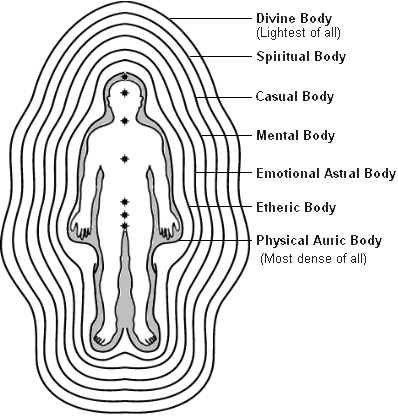
4. Final Stage (Nishpatti): When the Kundalini opens the third and final major knot, the Rudra Granthi, located around the Ajna chakra, the individual is one step away from achieving self-realization, followed by God-realization, and finally Yoga.
When discussing the Kundalini, it is essential to understand the different terminologies used to describe its components. Kundalini is often classified into three parts: the Core, the Fire, and the Energy. As illustrated below, the Core of the Kundalini is the Kundalini itself. It moves last and only after the Sushumna is sufficiently open and clean.
Cleansing is facilitated by the Fire of the Kundalini, which is the released or uncoiled energy. This energy resembles fire and purifies by burning away negativities and blockages in the energy body. These burned negativities are expelled from the body. If the crown chakra is open, the energy exits through it. Once the Sushumna is fully open, this energy continuously flows outward around 1.5 to 2 meters (4.5 to 6 feet) from the crown chakra.
This continuous flow enables 24/7 cleansing, even during sleep. By morning, you awaken cleaner than before. This rapid and consistent cleansing process aims to open the heart chakra more quickly.
 |
 |
| The Core, the Fire, and the Energy of Kundalini | |
Is it Kundalini?
Nowadays, Kundalini is a popular topic. Many people are discussing and practicing Kundalini. However, it is important to be cautious, as not every movement of energy along your sushumna, heat in the lower part of your body, or energy in your crown chakra is necessarily Kundalini.
The energy moving along your sushumna can be another type of chi. For example, if you are channeling energy or drawing Reiki symbols along the sushumna, you may feel energy movement there. If you draw symbols or channel energy to the chakras along the sushumna, the sensation will last longer due to the stimulation of the chakras, resulting in significant activity in that area. Heat in the lower part of your body can also be caused by chakra activity or Kundalini stimulation, but it does not necessarily mean Kundalini is awakened. Similarly, when checking the energy at the top of your head, remember that the crown chakra is located there. Thus, the energy you feel may simply be from the crown chakra.
How can you tell if the energy you are experiencing is truly Kundalini energy? If your Kundalini is genuinely awakened and the entire sushumna is open, you should feel energy extending 1.5 to 2 meters (4.5 to 6 feet) above your head. This energy will feel like it is spraying from the top of your head. If you make a cutting movement across the energy fountain, you will sense an upward-flowing current. The most accurate way to verify Kundalini energy is by using your Inner Heart. Only your Inner Heart knows the truth. By relying on your Inner Heart, you will never lose your way on your spiritual journey.
Stepping Stones
In the evolution of Kundalini, there are some significant stepping stones. Generally, when Kundalini completes its work of burning karma, stress, and blockages, emptiness remains. This emptiness develops inside and around the sushumna, typically growing faster near one of the three Granthis, depending on the type of meditation practiced. For instance, in self-inquiry meditation, this emptiness tends to grow faster around the Rudra Granthi, leading to the realization that there is no "I." This is called Self-Realization, a major stepping stone. If the focus is on the Vishnu Granthi, such as in Bhakti yoga or Christianity, the heart awakens first, resulting in a state of God-Realization, though the "I" thought remains. In tantra and karma yoga, the Brahma Granthi awakens first, leading to body-awakening, where disease and physical issues are resolved.
A. Rudra Granthi Full Awakening - Self-Realization, the understanding that there is no "I."
B. Vishnu Granthi Full Awakening - God-Realization, the understanding that all is God or Divine.
C. Brahma Granthi Full Awakening - Body-Awakening, achieving radiant health and immunity to most ailments.

Full kundalini awakening - All Granthis partially open.

|
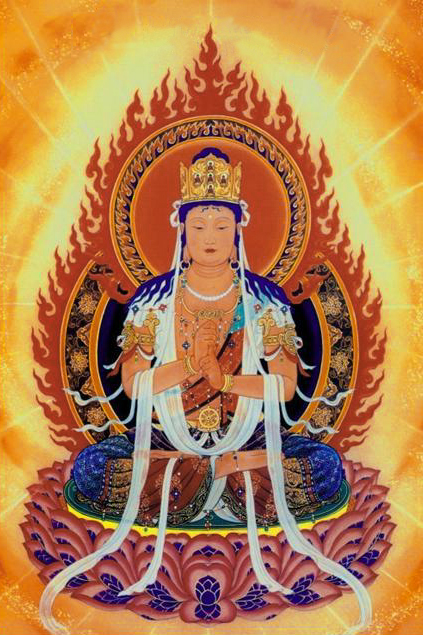
|
|---|---|
| Rudra Granthi and Vishnu Granthi Open |
All Three Granthis Open |
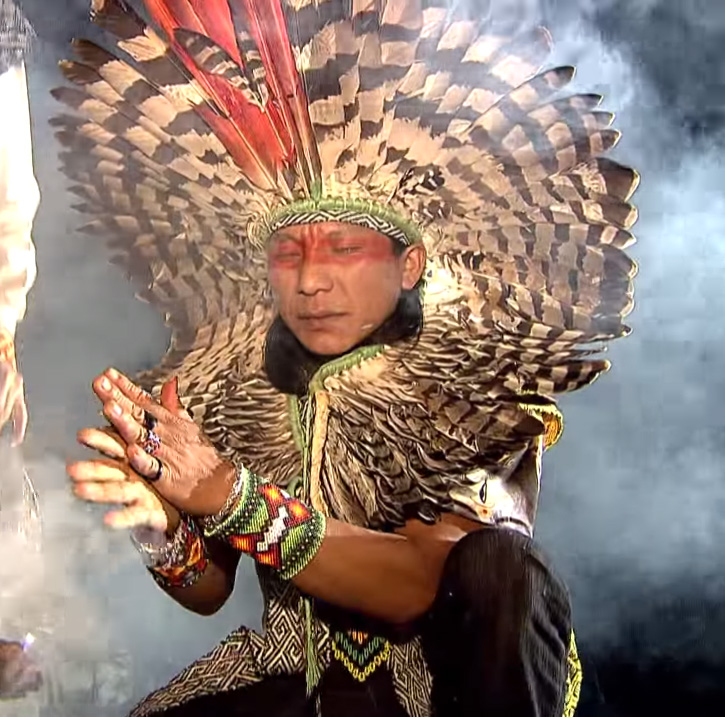
Many cultures and tribes use different symbologies to describe the same phenomenon, among which the Buddhists were the most prominent. 
All three Granthis open, and the body begins to dissolve: Body of Light - the Rainbow Body. |
|
Originally, the Kundalini was focused on sexual energies, moving them upwards through the sushumna, where it burns blockages and simultaneously opens the Brahma Granthi to maintain radiant health. This was historically the fastest and most powerful way of utilizing the Kundalini, often combined with herbs and mushrooms to enhance its effects.
This practice can be clearly seen in Buddhist and Indian art, such as the Shiva Lingam (see below). Great masters of the past preferred this path above others. However, in modern times, most religions have moved away from sexual energy practices, shifting towards devotional or self-inquiry meditations. This change occurred because the tantric approach is challenging, with potential distractions, and modern society tends to stigmatize sexual energy. Even natural states, like nudity, are frowned upon due to societal fears. Despite this, it is essential to recognize that sexual energies remain the most potent force for Kundalini evolution at any stage.

Samantabhadra
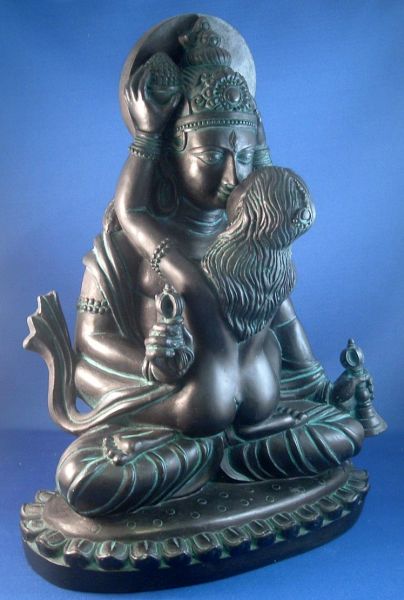
Shiva & Shakti

Uchishta Ganapathy

As you can see in these pictures, not only India and Tibet have studied Kundalini, but almost every major religion has recognized its powerful potential.

Winged Heart: The Tughra (symbol) of Sufi master Inayat.
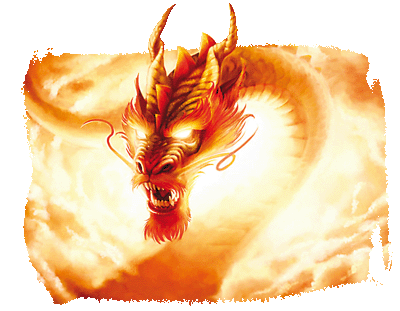
|
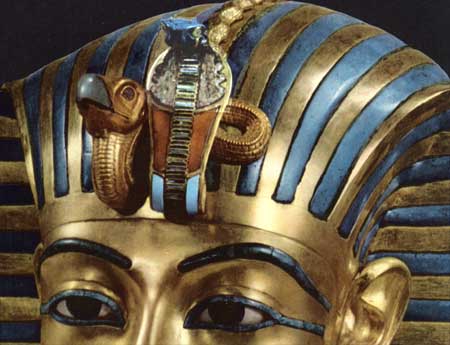
|
|---|
Perhaps the most extreme tantric practice involving Kundalini and death comes from the Aghoris in northern India. Known as Shava Sadhana, it is an incredibly intense practice. However, it is better to trust that it is extreme and avoid further research. Some things are best left unexplored.
An excellent explanation of the Kundalini by Swami Khecaranatha.